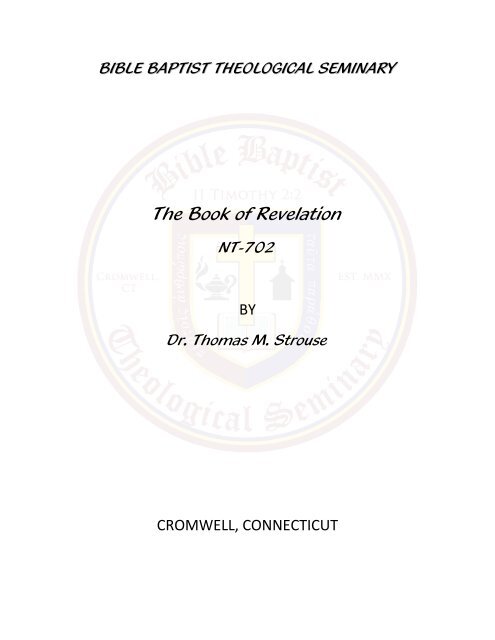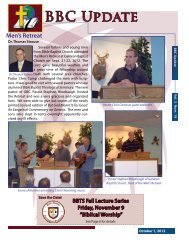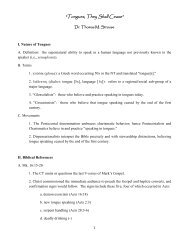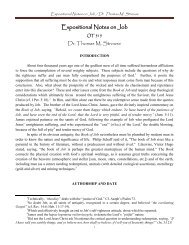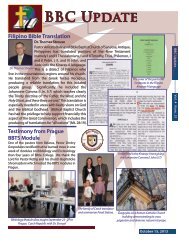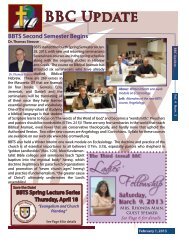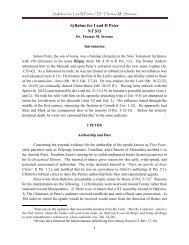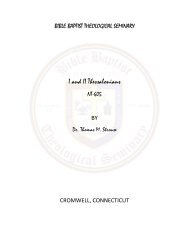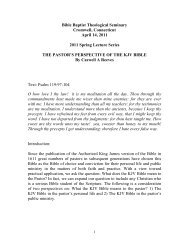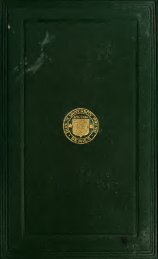The Book of Revelation - Bbc-cromwell.org
The Book of Revelation - Bbc-cromwell.org
The Book of Revelation - Bbc-cromwell.org
You also want an ePaper? Increase the reach of your titles
YUMPU automatically turns print PDFs into web optimized ePapers that Google loves.
BIBLE BAPTIST THEOLOGICAL SEMINARY<strong>The</strong> <strong>Book</strong> <strong>of</strong> <strong>Revelation</strong>NT-702BYDr. Thomas M. StrouseCROMWELL, CONNECTICUT
<strong>The</strong> book <strong>of</strong> <strong>Revelation</strong>:“For the Testimony <strong>of</strong> Jesus is the Spirit <strong>of</strong>Prophecy”Dr. Thomas M. StrouseINTRODUCTION<strong>The</strong> Lord Jesus Christ gave His last revelation (apocalupsis) through the Apostle John,exiled on the isle <strong>of</strong> Patmos, to seven New Testament (NT) churches in Asia Minor, around AD95. <strong>The</strong> book follows the divinely inspired outline <strong>of</strong> 1:19—<strong>The</strong> things which thou hast seen(1:9-20), <strong>The</strong> things which are (2-3), and <strong>The</strong> things which shall be hereafter (4-22). <strong>The</strong>Futuristic interpretation follows the Johannine outline literally, holding that chapters 4-22 are yetfuture, following the Rapture (I <strong>The</strong>s. 4:13-17), while the Allegorical (figurative), Historical(history <strong>of</strong> the “church”), and Preterist (fulfilled in first century) views <strong>of</strong> interpretation arescripturally feckless. <strong>The</strong> number seven is predominate in the <strong>Book</strong> (i.e., seven stars, angels,seven-fold Spirit, seals, trumpets, vials, thunders, heads, crowns, mountains, kings, etc.),referring to the sense <strong>of</strong> completion, although in many contexts it must be understood literally.Although the revelation about the Tribulation (Rev. 4-19) is essentially chronological (SevenSeals, then Seven Trumpets, then Seven Vials), there are several chapters which areparenthetical, giving the reader explanations about simultaneous activity in heaven orsummarizations. <strong>The</strong>re are many parallels between the last book <strong>of</strong> the Bible and the first(Genesis). Understanding <strong>of</strong> <strong>Revelation</strong> requires a thorough knowledge <strong>of</strong> key propheticpassages such as Daniel 9:24-27, 11:36-45; Mt. 24-25; I <strong>The</strong>s. 4-5; and II <strong>The</strong>s. 3.“<strong>The</strong> things which thou hast seen”Background(Rev. 1:1-20)CHAPTER ONE<strong>The</strong> flow <strong>of</strong> the chapter takes the reader from the Introduction (vv. 1-8), including Prologue (1:1-3) and Salutation (1:4-8), to the first main division <strong>of</strong> “<strong>The</strong> things which thou hast seen” (vv. 9-20).Exposition
Rev.1:1-8Prologue (Rev. 1:1-3)<strong>The</strong> Father gave revelation to the Son to reveal unto His servants through Johnconcerning the future events which the writer saw. <strong>The</strong> apostle records the first <strong>of</strong> sevenbeatitudes (“blessed”—1:3; 14:13; 16:15; 19:9; 20:6; 22:7; and 22:14). This blessing is for thosewho read, hear, and keep the book <strong>of</strong> <strong>Revelation</strong> because on the imminent return <strong>of</strong> Christ.Salutations (Rev. 1:4-8)John wrote to seven churches in Asia Minor from the eternal God, the One “which is andwhich was, and which is to come.” He included all three Members <strong>of</strong> the Godhead as the source<strong>of</strong> grace and peace (“from him…from the seven Spirits…from Jesus Christ”). He described theresurrected Jesus Christ and his redemptive work including salvation and sanctification. Hisreturn is imminent as He is the eternal God Who breaks into the realm <strong>of</strong> time.John’s Christological Vision (Rev.1:9-18)Rev. 1:9-20John identified who he was, where he was, and when he received divine revelation. <strong>The</strong>One Who spoke to him, commanding him to write (cf. 1:11, 19; 2:1, 8, 12, 18; 3:1, 7, 14; (10:4);14:13; 19:9; and 21:5) to seven churches, was the resurrected Lord Jesus Christ. He describedthe Lord’s glory, His relationship to the churches, and John’s reaction.John’s Command to Write (Rev. 1:19-20)<strong>The</strong> Lord Jesus Christ gave John the inspired outline and content <strong>of</strong> prophecy for theseven churches, identifying the mystery <strong>of</strong> the seven stars and candlesticks.<strong>The</strong>ological Concerns<strong>The</strong> recipients <strong>of</strong> prophecy are the Lord’s candlesticks. Those who are not in one <strong>of</strong> theLord’s assemblies will have limited illumination in understanding prophecy in general and theApocalypse in specific (cf. I Tim. 3:15). For instance, Roman Catholic and Protestantcommentators continually misunderstand the interpretation <strong>of</strong> <strong>Revelation</strong> (vv. 1-8). <strong>The</strong> presence<strong>of</strong> the resurrected Christ in the midst <strong>of</strong> His assemblies reminds the reader <strong>of</strong> Christ’s GreatCommission (vv. 9-18; cf. Mt. 28:19-20; 18:20). Protestant theology posits the falseinterpretation that the seven churches represent seven ages <strong>of</strong> the “Church” (i.e., universalchurch) dispensation.It is significant that John was in the Spirit on the Lord’s day (Sunday), as he receivedrevelation for the Lord’s churches (v. 10). <strong>The</strong> expression “Son <strong>of</strong> man” harks back to Dan. 7:13as prophecy <strong>of</strong> the Messiah. <strong>The</strong> seven stars in the Lord’s right hand are the seven pastors <strong>of</strong> the
seven respective churches, which pastors are under the control <strong>of</strong> Christ as long as they remain insubmission to His words.Textual IssuesVerse 1:5—Critical Text (CT) reads “loosed (luo) us” whereas the Received Text (TR) reads“washed (louo) us.”Verse 1:8—CT omits “the beginning and the ending.”Verse 1:18—CT reverses the TR order “<strong>of</strong> hell and <strong>of</strong> death.”Summary <strong>of</strong> Chapter OneAfter giving his prologue and salutation, John revealed the resurrected Christ’s desire forhim to write, following the aforementioned outline, by unfolding revelation about prophecy, forthe Lord’s only ecclesiological institution <strong>of</strong> this age, the visible assembly <strong>of</strong> baptized believers.Background“<strong>The</strong> things which are”(Rev. 2-3)CHAPTER TWOThis chapter presents the cities (Ephesus [vv. 1-7], Smyrna [vv. 8-11], Pergamos [vv. 12-17], and Thyatira [vv. 18-29]) in which four <strong>of</strong> the seven churches to which <strong>Revelation</strong> waswritten, focusing on the message to each angel/pastor.Exposition<strong>The</strong> Church at Ephesus (Rev. 2:1-7)Rev. 2:1-29<strong>The</strong> Lord revealed to the pastor <strong>of</strong> the Ephesian assembly His commendations for thechurch’s service and for her (i.e., the ekklesia) hatred <strong>of</strong> the Nicolaitanes, but also Hiscondemnation for her leaving her first love (cf. Eph. 1:4, 15). He gave soteriological promises tothose who would repent and overcome.<strong>The</strong> Church at Smyrna (Rev. 2:8-11)Christ commended the church at Smyrna because <strong>of</strong> her works in spite <strong>of</strong> poverty andtribulation, and warned <strong>of</strong> ten days <strong>of</strong> more tribulation, encouraging her to be “faithful untodeath.” Overcomers would not be hurt by the second death, He promised.
<strong>The</strong> Church at Pergamos (Rev. 2:12-17)<strong>The</strong> pastor <strong>of</strong> the church at Pergamos received Christ’s strong redress for her toleration <strong>of</strong>the doctrine <strong>of</strong> Balaam and the doctrine <strong>of</strong> the Nicolaitanes, since the church was situated inSatan’s stronghold. <strong>The</strong> remnant within was to repent and overcome for eternal soteriologicalblessings<strong>The</strong> Church at Thyatira (Rev. 2:18-29)<strong>The</strong> Lord Jesus, omniscient about the assembly at Thyatira and the member’s faithfulservice, nevertheless condemned severely the woman teacher Jezebel (cf. I Ki. 16:31 ff.; 21:25;II Ki. 9:7) who espoused her doctrinal and practical errors throughout the assembly. <strong>The</strong>remnant was to hold fast the truth until the Lord comes back.<strong>The</strong>ological Concerns<strong>The</strong> meaning <strong>of</strong> “overcoming” involves both the position and practice <strong>of</strong> the believer.John revealed that the Christian has the position as overcomer, since he identifies with ChristWho overcame the world (cf. Jn. 16:33), and the power to overcome since he is born <strong>of</strong> God (IJn. 5:1-5). Those who overcome are true Christians which will receive the soteriologicalblessings in heaven. Those who do not repent, even though pr<strong>of</strong>essed Christians in Baptistchurches, will perish since their pr<strong>of</strong>ession is not genuine.<strong>The</strong> assemblies were still the Lord’s candlesticks until He determined they no longer hadthe status. Even though some churches had severe doctrinal and practical errors, the remnantwas to repent and overcome, and hopefully purify their respective assemblies with biblicaldoctrine and practice. <strong>The</strong> words <strong>of</strong> Christ’s message were to the respective pastors, who wereheld in His right hand <strong>of</strong> power and control, but the whole congregation was entreated to hearand respond appropriately to maintain candlestick status.Textual IssuesVerse 13—CT (and modern versions such as NASV, NIV, etc.) omits “thy works.”Summary <strong>of</strong> Chapter <strong>of</strong> TwoThree <strong>of</strong> the four churches (Ephesus, Pergamos, and Thyatira) received Christ’scondemnation and warning <strong>of</strong> loss <strong>of</strong> candlestick status. Only the church at Smyrna receivedcommendation alone, and it was impoverished and persecuted. In all cases, both the pastor andassembly members had the responsibility to respond to the Lord’s instruction.BackgroundCHAPTER THREE
<strong>The</strong> Lord Jesus Christ concluded His addresses to the angels <strong>of</strong> the last three (Sardis [vv.1-6], Philadelphia [vv. 7-13], and Laodicea [vv. 14-22]) <strong>of</strong> the seven churches in Asia Minor,condemning two <strong>of</strong> the three.Exposition<strong>The</strong> Church at Sardis (Rev. 3:1-6)Rev. 3:1-22<strong>The</strong> church had a testimony <strong>of</strong> life and yet was spiritually dead—a good reputation but abad reality. Only a few within, presumably including the pastor, were not defiled with the error,and they were to hold fast and repent. <strong>The</strong>ir names would not be blotted out <strong>of</strong> the book <strong>of</strong> life.<strong>The</strong> Church at Philadelphia (Rev. 3:7-13)<strong>The</strong> Lord recognized the obedience <strong>of</strong> this assembly, albeit little in strength, andpromised that he would deliver them from the hour <strong>of</strong> world-wide Tribulation. <strong>The</strong> promise <strong>of</strong>the imminent return <strong>of</strong> Christ is coupled with the church’s continued obedience to be in existencewhen the Lord returns.<strong>The</strong> Church at Laodicea (Rev. 3.14-22)<strong>The</strong> Lord Jesus Christ reproved the pastor <strong>of</strong> this lukewarm assembly because <strong>of</strong> herwealth. It seems that the Lord was on the outside attempting to get in the assembly, standing atthe door knocking.<strong>The</strong>ological Concerns<strong>The</strong> Lord warned the assemblies that He would come as a thief and remove theircandlestick status, unbeknownst to them. As churches become large they risk the danger <strong>of</strong>doctrinal impurity, and the consequent loss <strong>of</strong> divine approval and status.<strong>The</strong> book <strong>of</strong> life contains all who were ever conceived and reduces down to all whoreceive the Savior by meeting the conditions <strong>of</strong> repentance and faith (cf. Rev. 20:12-15).Apparently when an unrepentant sinner dies, he is blotted out <strong>of</strong> the book <strong>of</strong> life (cf. Rev. 13:8).Textual IssuesRev. 3:10—Although the texts <strong>of</strong> the CT and TR are the same with regard to the preposition ek,the meaning <strong>of</strong> ek is “from” and not “out <strong>of</strong>” because Paul already instructed the <strong>The</strong>ssalonianchurch that she would be gathered unto Christ before the Day <strong>of</strong> the Lord, which is, theTribulation and Millennium, in I <strong>The</strong>s. 4:17, 5:2.Summary <strong>of</strong> Chapter Three
<strong>The</strong> last three churches received similar commendations/condemnations from the Lord asdid the first four. All were to remain faithful, repent, and continue until the Lord comes back.None did! For the true Christians in Baptist churches who show their status <strong>of</strong> overcoming bythe practice <strong>of</strong> overcoming, there are many blessings yet to come in heaven.Background“<strong>The</strong> Things WhichShall Be Hereafter”(Rev. 4-22)CHAPTER FOUR<strong>The</strong> Apostle John was invited, in his vision, to the throne room <strong>of</strong> God, and saw thetwenty-four elders, four beasts, and their worship <strong>of</strong> God involving singing and the casting <strong>of</strong>crowns before the throne.Exposition<strong>The</strong> Invitation to Heaven (Rev. 4:1-3)Rev. 4:1-11<strong>The</strong> voice associated with the trumpet and the imperative “come up hither” suggests thatthis pictures the Rapture as predicted by Paul (I <strong>The</strong>s. 4:16-17). This heavenly invitationprecedes the final section <strong>of</strong> the inspired outline (Rev. 1:19), as the promise indicates John willbe shown the “things which must be hereafter” (ha dei genesthai meta tauta). <strong>The</strong> “hereafter”(meta tauta) <strong>of</strong> 4:1 fulfills the “hereafter” (meta tauta) <strong>of</strong> 1:19. <strong>The</strong> “raptured” Apostle Johnsaw the heavenly throne and one Who sat upon it, apparently the triune God. He used preciousgems to describe the brilliance <strong>of</strong> the setting.Those in the Throne Room (Rev. 4:4-7)
After seeing the heavenly throne with God upon it, John saw twenty-four elders sittingaround the throne, apparently as representatives <strong>of</strong> church age saints (since they had whiteraiment and golden crowns), and four beasts (zoon) likened unto a lion, calf, face <strong>of</strong> man, and aflying eagle.Heavenly Worship (Rev. 4:8-11)<strong>The</strong> apostle observed the four beasts singing the first <strong>of</strong> five recorded hymns <strong>of</strong> praise (v.8; vide also 4:11; 5:9-10, 12, and 13), and the elders casting their crowns before the throne andsinging the second <strong>of</strong> the hymns <strong>of</strong> praise (v. 11). <strong>The</strong> Scripture speaks <strong>of</strong> several crownselsewhere: I Cor. 9:25; Phil. 4:1; II Tim. 4:8; Jam. 1:12; I Pet. 5:4; and Rev. 3:11.<strong>The</strong>ological Concerns<strong>The</strong> identity <strong>of</strong> the twenty-four elders as church age saints follows these lines <strong>of</strong>argument: 1) the rapture is exclusively for NT saints, OT saints will be resurrected following theTribulation; 2) the white raiment indicates they have been saved; 3) the golden crown(stephanos) is the victor’s crown, suggesting they have been judged at the Bema <strong>of</strong> Christ; 4)they were kings and priests as the Lord promised (cf. Rev. 1:6 with 5:10).Textual IssuesRev.4:11—CT changes to the imperfect verb esan (“they were”) instead <strong>of</strong> the present eisin(“they are”) in the TR.Summary <strong>of</strong> Chapter FourJohn’s vision has as it were, revelation about the pre-Tribulation rapture and immediatepresence in the throne room with God, the elders, and the beasts, depicting the next propheticevents in heaven and on earth.BackgroundCHAPTER FIVEChapter Five continues the throne room scene and advances the revelation, indicating thatthe seven-sealed book must be opened, and only the Lamb is worthy for that task.Exposition<strong>The</strong> Sealed Scroll (Rev. 5:1-4)Rev. 5:1-14<strong>The</strong> new focus in the throne room was the seven-sealed book or scroll, and the queryabout Who was worthy to open it, causing John to weep.
<strong>The</strong> Worthy Lamb (Rev. 5:5-7)One <strong>of</strong> the elders instructed John to stop weeping, because the identity <strong>of</strong> the Worthy Onefulfilled the OT prophecy concerning the Lion <strong>of</strong> Judah and the Root <strong>of</strong> David. Furtherinformation indicated that the slain Lamb, the resurrected Lord Jesus Christ, took the scroll fromthe Father Who sat upon the throne.<strong>The</strong> Worship <strong>of</strong> the Lamb (Rev. 5:8-14)<strong>The</strong> Lamb took central position to receive worship, as the twenty-four elders, andmultitudes <strong>of</strong> others, as well as angels and beasts, and all creatures in heaven and earth sangpraise to the Lord in the final three hymns <strong>of</strong> praise.<strong>The</strong>ological Concerns<strong>The</strong> seven-sealed scroll is apparently the book <strong>of</strong> future judgment and redemption, asrevealed in the rest <strong>of</strong> the Apocalypse (Rev. 6:1-17; 8:1-5).Textual IssuesRev. 5:9—the CT omits the TR’s “us” (hemas), obfuscating who has been purchased withChrist’s blood. Only men, and not angels or beasts, have been purchased with the precious blood<strong>of</strong> Christ.Summary <strong>of</strong> Chapter Five<strong>The</strong> importance <strong>of</strong> this throne room scene registers for the reader when the visionpresents the concern about Who may open the scroll, weeping over the concern, and rejoicing inthe Lamb Who does take the scroll, worshipping him in anticipation <strong>of</strong> unsealing the scroll.BackgroundCHAPTER SIX<strong>The</strong> vision reveals the opening <strong>of</strong> six <strong>of</strong> the Seven Seal Judgments, which begin theworld-wide judgments <strong>of</strong> the Tribulation period, as Christ prophesied (Mt. 24:4-8).Exposition<strong>The</strong> First Seal Judgment (Rev. 6:1-2)Rev. 6:1-17<strong>The</strong> First Judgment was the rider on a white horse bringing false peace, which fits theAnti-Christ’s deception.<strong>The</strong> Second Seal Judgment (Rev. 6:3-4)
wars.<strong>The</strong> next Seal Judgment depicted the red horse taking peace from the earth in the form <strong>of</strong><strong>The</strong> Third Seal Judgment (Rev. 6:5-6)<strong>The</strong> Third Seal was the black horse which represented famine.<strong>The</strong> Fourth Seal Judgment (Rev. 6:7-8)hell.<strong>The</strong> Fourth Seal Judgment was the pale green (cloros) horse which represented death and<strong>The</strong> Fifth Seal Judgment (Rev. 6:9-11)<strong>The</strong> next Seal was the picture <strong>of</strong> Tribulation saints slain during the Tribulation period.<strong>The</strong> Sixth Seal Judgment (Rev. 6:12-17)<strong>The</strong> Sixth Judgment resulted in a world-wide earthquake, falling stars, and extreme terroron earth.<strong>The</strong>ological concerns<strong>The</strong> Seal Judgments are indeed judgments, so the white horse does not picture Christ andrighteousness, but the judgment <strong>of</strong> the false peace with which the Antichrist will deceive theworld, acting in the place <strong>of</strong> Christ and against Him.Textual IssuesRev. 6:17—CT replaces the TR “his” (autou) wrath with “their” (auton) wrath.Summary <strong>of</strong> Chapter Six<strong>The</strong> six Seal Judgments are world-wide, demonstrating the beginning <strong>of</strong> God’s wrathupon sinful mankind.BackgroundCHAPTER SEVENLeaving the chronological sequence <strong>of</strong> Seal Judgments in Chapter Six, the visionrecorded two groups <strong>of</strong> saints in the Tribulation who will experience redemption—the 144,000and the multitudes saved by receiving their message.ExpositionRev. 7:1-17
<strong>The</strong> Sealing <strong>of</strong> the 144,000 (Rev. 7:1-8)<strong>The</strong> Lord will protect His witnesses by sealing them before possible hurt to them. Hesealed 12,000 Jews from the twelve tribes, excluding Ephraim and Dan, but referring to the tribes<strong>of</strong> Joseph and Levi, and giving a total <strong>of</strong> 144,000.<strong>The</strong> Salvation <strong>of</strong> the Multitudes (Rev. 7:9-17)Multitudes will be redeemed by the blood <strong>of</strong> the Lamb during the Tribulation, and theywill serve him forever.<strong>The</strong>ological Concerns<strong>The</strong> 144,000 will not be Christians, or any select church group, but will be virgin Jewishmen from the twelve Jewish tribes (cf. Rev. 14). Some have speculated that the omission <strong>of</strong> Danwas because the Antichrist would come from this tribe.Textual IssuesRev. 7:12—some MSS omit “amen.”Summary <strong>of</strong> Chapter Seven<strong>The</strong> Lord will insure that the 144,000 Jewish evangelists will be sealed and protected inorder to evangelize the multitudes that will be saved during the Tribulation.BackgroundCHAPTER EIGHTThis chapter focuses on the opening <strong>of</strong> the Seventh Seal Judgment, which Seal containsthe Seven Trumpet and Seven Vial Judgments. Chapter eight follows chapter six in sequence,emphasizing subsequent developments concluding with Christ’s Second Coming.Exposition<strong>The</strong> Opening <strong>of</strong> the Seventh Seal (Rev. 8:1)Rev. 8:1-13<strong>The</strong> opening <strong>of</strong> the Seventh Seal Judgment will be a solemn and momentous occasion inworld history, giving respite for an additional 30 minutes, as the Lamb will activate theculminating events <strong>of</strong> His wrath.<strong>The</strong> Seven Angels (Rev. 8:2-6)
<strong>The</strong> seven angels with the seven trumpets will be God’s agents to carry out His judgmenton the world when they sound out their respective Trumpet Judgments, as the Lord will respondin vengeance to the saints’ prayers.<strong>The</strong> First Trumpet Judgment (Rev. 8:7)This Judgment will affect nature, sending fire with hail to destroy earth vegetation,similar to the fourth plague against Egypt (Ex. 9:23 ff.)<strong>The</strong> Second Trumpet Judgment (Rev. 8:8-9)<strong>The</strong> Second Trumpet will affect the sea waters as a large fiery mountain is thrown intothe Mediterranean Sea turning one third <strong>of</strong> it to blood, and destroying life and ships (cf. Ex.7:20).<strong>The</strong> Third Trumpet Judgment (Rev. 8:10-11)A star named Wormwood will fall into the water sources on Earth, making the waterbitter (cf. Ex. 15:23-24).<strong>The</strong> Fourth Trumpet Judgment (Rev. 8:12-13)<strong>The</strong> Fourth Trumpet Judgment will smite the heavenly bodies and cause darkness on theearth, similar to the ninth plague (Ex. 10:21 ff.). As if these four Trumpet Judgments were notenough, an angel warned <strong>of</strong> three more woes <strong>of</strong> the last three Trumpet Judgments which willdevastate earth inhabitants.<strong>The</strong>ological Concerns<strong>The</strong> Lord will avenge His Tribulation elect as they pray for divine judgment on theenemies <strong>of</strong> the righteous God, as He promised (Lk. 18:7). <strong>The</strong> “inhabiters” (katoikousin = kataoikousin = ecumenical) <strong>of</strong> the earth will probably be the ecumenical movement (cf. Rev. 3:10).Textual IssuesRev. 8:13—the CT substitutes “eagle” (aetou) for the TR’s word “angel” (angelou).Summary <strong>of</strong> Chapter Eight<strong>The</strong> Seventh Seal Judgment will commence in this chapter, beginning the terrible wrath<strong>of</strong> the Lamb, continuing all the way to the coming <strong>of</strong> Christ in Rev. 19.BackgroundCHAPTER NINE
<strong>The</strong> fifth angel announced the first woe (8:13) which was a personage, apparently namedAbaddon and Apollyon, fall to the earth at the midpoint <strong>of</strong> the Tribulation. His presence willunleash demons from the abyss to torment men. <strong>The</strong> next woe (the Sixth Trumpet Judgment) willunloose four angels and activate a 200,000,000 army which will kill one third <strong>of</strong> mankind, butalso will harden the remainder in their unrepentant state.Exposition<strong>The</strong> Fifth Trumpet (Rev. 9:1-12)Rev. 9:1-21This woe will involve Satan’s fall from heaven (cf. Rev. 12:7-12) and the unleashing <strong>of</strong>his demon army from the abyss. <strong>The</strong>ir sting will inflict pain for five months, presumablybeginning the Great Tribulation. Satan is the angel-king named Abaddon and Apollyon,Hebrew and Greek titles for destruction. This woe is the beginning <strong>of</strong> the intense pain anddestruction <strong>of</strong> the last three and half years <strong>of</strong> the seven year Tribulation.<strong>The</strong> Sixth Trumpet (Rev. (9:13-21)<strong>The</strong> second woe will unloose four bound angels (demons) in the Euphrates. Followingthem will be a 200,000,000 army <strong>of</strong> fierce horses out <strong>of</strong> whose mouths will issue destruction,killing one third <strong>of</strong> mankind. <strong>The</strong> remaining two thirds will not repent <strong>of</strong> their murders, drugs(pharmakeion), fornication or thievery.<strong>The</strong>ological Concerns<strong>The</strong> Tribulation is Daniel’s seventieth week (cf. Dan. 9:24-27), or heptad <strong>of</strong> seven years,divided into two units <strong>of</strong> three and half years (1260 days or 42 months).Textual IssuesRev. 9:13—the CT omits “four” (found in the TR) with reference to the horns <strong>of</strong> the altar.Summary <strong>of</strong> Chapter NineThis frightening chapter depicted two <strong>of</strong> the last three woe judgments, including the fall<strong>of</strong> Satan to the earth, the unloosing <strong>of</strong> his demonic army, and the unloosing for four more angelswith their army which will destroy one third <strong>of</strong> mankind.BackgroundCHAPTER TENThis chapter presents a parenthetical hiatus <strong>of</strong> the activity in heaven and earth. <strong>The</strong>mighty angel holds a little book which apparently contains further judgment. John is told not to
write, but to seal up the seven trumpet judgments. <strong>The</strong> angel declared that there would be nomore delay as the mystery <strong>of</strong> God would be finished. John took the little book and ate it asinstructed, sensing that it was bittersweet and being informed that he would prophesy again.Exposition<strong>The</strong> Mighty Angel (Rev. 10:1-4)Rev. 10:1-11Another mighty angel, distinct from the one in 5:2, and therefore not Christ, appearedwith a little book in his hand. This parenthetical interlude was somber, suggesting the ominousforeboding <strong>of</strong> the culmination <strong>of</strong> God’s wrath. Upon hearing the seven thunders, the ApostleJohn started to write but was prohibited. Apparently the Lord did not want certain judgmentalrevelation inscripturated at this time.<strong>The</strong> Consummation <strong>of</strong> Judgment (Rev. 10:5-7)<strong>The</strong> mighty angel straddling the sea and earth swore by Christ, the Creator, andannounced that there would be no more delay in bringing final judgment to earth (cf. 6:10).With the Seventh Trumpet Judgment would commence the events leading to the culmination <strong>of</strong>the mystery <strong>of</strong> God in establishing the Millennial kingdom.<strong>The</strong> Consumption <strong>of</strong> the Little <strong>Book</strong> (Rev. 10:8-11)In similar manner with Ezekiel (2:9-3:3), John received instruction to eat the little book,producing the bittersweet effect upon him. As the prophet <strong>of</strong> God writing the Apocalypse, therighteous judgments would be sweet to him as a believer, but bitter as he realized multitudeswould receive the wrath <strong>of</strong> the Lamb. As he continued to inscripturated the <strong>Book</strong> <strong>of</strong> <strong>Revelation</strong>,his prophesy would go before the multitudes including kings.<strong>The</strong>ological ConcernsEzekiel received instruction to eat a scroll <strong>of</strong> woe about the Lord’s judgment onJerusalem. As he consumed the roll <strong>of</strong> a book, it became as honey <strong>of</strong> sweetness in his mouth.<strong>The</strong> judgmental messages which the Lord’s prophets preached weighed heavy upon them sincethey recognized many would incur the wrath <strong>of</strong> God, including their family and friends.Textual IssuesRev. 10:1—some MSS have biblion instead <strong>of</strong> TR’s biblaridion.Summary <strong>of</strong> Chapter TenThis second parenthetical chapter depicted the heavenly pause before the finalconsummation <strong>of</strong> the wrath <strong>of</strong> the Lamb.
CHAPTER ELEVENBackgroundBefore the <strong>Book</strong> <strong>of</strong> <strong>Revelation</strong> gives additional sequential activity, the Lord reveals moreparenthetical information. Since Chapter Nine revealed events up through the mid-point <strong>of</strong> theTribulation, Chapter Eleven summarizes events relating to the close <strong>of</strong> the first three and halfyears before proceeding to the Seventh Trumpet Judgment or third woe (11:15 ff.). <strong>The</strong> twowitnesses who had been protecting the Tribulation Temple will be killed by the Antichrist, andsubsequently resurrected.Exposition<strong>The</strong> Tribulation Temple (Rev. 11:1-2)Rev. 11:1-19<strong>The</strong> temple predicted by the Apostle Paul that the Son <strong>of</strong> Perdition will defile (II <strong>The</strong>s.2:4) receives this first notice in the <strong>Book</strong> <strong>of</strong> <strong>Revelation</strong>. John was instructed to measure thetemple, but not the court, which will be under gentile dominion for the final forty two months <strong>of</strong>the Tribulation.<strong>The</strong> Two Witnesses (Rev. 11:3-12)Concerning the two unnamed witnesses, John recorded their length <strong>of</strong> ministry as 1260days, their supernatural power, their death, and their ultimate resurrection. <strong>The</strong>se witnessesprotected the Tribulation temple from the Antichrist during the first three and a half years, aswell as smote the earth with the Seal and Trumpet plagues (9:20), evincing hatred from bothSatan and mankind. <strong>The</strong>ir death with bring world-wide rejoicing at the mid-point <strong>of</strong> theTribulation, and after three and a half days, the Lord will resurrect them, invoking a similar“resurrection” effort from the Antichrist (13:1-3).<strong>The</strong> Third Woe (Rev. 11:13-14)A great earthquake will occur in Jerusalem, commencing the third woe or SeventhTrumpet Judgment.<strong>The</strong> Seventh Trumpet (Rev. 11:15-19)This pericope will give the heavenly perspective <strong>of</strong> the seventh angel sounding. Inheaven, joy and worship will evince from those in heaven as God will pour out His wrath onthose on earth.<strong>The</strong>ological Concerns
<strong>The</strong> Scriptures refer to four temples in Israel’s history: the Solomon, the Zerubbabel-Herod, the Tribulation, and the Millennium temples.<strong>The</strong> persistent and contrived efforts by Bible commentators to identify the two witnessesare unnecessary since the Scriptures do not reveal who they are. Although Moses, Elijah, andEnoch have received candidate status, there is no reason not to understand the witnesses as futureindividuals empowered by God for this task. Commentators seem to put more energy intoidentifying the witnesses than in exegeting the passage.Textual IssuesSummary <strong>of</strong> Chapter ElevenAs the two witnesses protect the temple and smite the earth with judgments, they willreceive fierce hatred for their short three and half year ministry. At the mid-point <strong>of</strong> theTribulation they will be slain but then resurrected, commencing the last three and half years <strong>of</strong>judgment, about which heaven will rejoice.BackgroundCHAPTER TWELVEChapter Twelve continues the parenthetical material, summarizing Israel’s history andrevealing Satan’s fall from heaven and pursuit after the Lord’s remnant in the last three and ahalf years. Predominate personages in this chapter and the next are the woman, the child, thedragon, Michael, the remnant, the first beast and the second beast.ExpositionRev. 12:1-17<strong>The</strong> History <strong>of</strong> the Remnant Nation (Rev. 12:1-6)Harking back to Gen. 37:9, the vision summarizes the history <strong>of</strong> the Jewish remnant fromJoseph to the birth and resurrection <strong>of</strong> Christ, to the current Great Tribulation persecution.<strong>The</strong> Heavenly Expulsion <strong>of</strong> Satan (Rev. 12:7-11)Although Satan lost his position in heaven with his initial sin (Isa. 14:12-15; Ezk.28:12-18; cf. Job 1:6), he will not lose his place until the mid-point <strong>of</strong> the Tribulation, when he does notprevail against Michael. Those in heaven will rejoice that salvation will be completed since theaccuser is expulsed.<strong>The</strong> Satanic Persecution <strong>of</strong> the Remnant (Rev. 12:8-17)
As there will be joy in heaven with his expulsion, there will be woe on earth. Satan’sAntichrist will intensify his persecution on the believing Jewish remnant.<strong>The</strong>ological ConcernsDuring the Tribulation, believers will have and keep the commandments <strong>of</strong> God,presumably the Scriptures. This truth recognizes that the Lord has made available Hisinscripturated revelation in every dispensation.Textual IssuesRev. 12:14—the words “half a time” are omitted in Codex C, but this omission does affect theKJV or many modern versions.Summary <strong>of</strong> Chapter TwelveSatan’s long-time hatred for Israel will culminate in his pursuit to persecute and destroythe believing Jewish remnant, whom the Lord will protect.BackgroundCHAPTER THIRTEENThis chapter focuses on two great evil personages, the first and second beast, or theAntichrist and the False Prophet, respectively. <strong>The</strong>ir nature and deception are revealed, alongwith the number <strong>of</strong> the Antichrist.Exposition<strong>The</strong> First Beast (Rev. 13:1-10)Rev. 13:1-18<strong>The</strong> first beast is both a system and a person, who will orchestrate a pseudo-resurrection(reincarnation [?]) and demand to be worshipped. His nature will be warlike as he has dominionover the people <strong>of</strong> the earth through the last three and a half years.<strong>The</strong> Second Beast (Rev. 13:11-14)<strong>The</strong> second beast, the False Prophet, will facilitate the worship <strong>of</strong> the Antichrist throughsupernatural miracles.<strong>The</strong> Number <strong>of</strong> the Beast (Rev. 13:15-18)<strong>The</strong> Antichrist will have power to control commerce by requiring all to receive his markwith his number 666.
<strong>The</strong>ological Concerns<strong>The</strong> Antichrist will be revealed after the Rapture (II <strong>The</strong>s. 2:2 ff.), and will besupernaturally energized by Satan. Christians will not know who he is and it is fruitless tospeculate, since even if he were alive, he would not be satanically energized yet. All kinds <strong>of</strong>efforts to understand his number <strong>of</strong> 666 is speculative and cannot be comprehended until afterthe Tribulation begins.Textual IssuesRev. 13:1—the CT reads “he (the beast) stood” instead <strong>of</strong> the TR “I stood.”Rev. 13:18—some MSS read 616 instead <strong>of</strong> 666.Summary <strong>of</strong> Chapter Thirteen<strong>The</strong> two beasts will control the political/economic and religious realms in the final years<strong>of</strong> the Tribulation, dominating the world in forceful control.BackgroundCHAPTER FOURTEENThis chapter gives John’s vision <strong>of</strong> the 144,000 standing with the Lamb at the outset <strong>of</strong>the Millennium. Furthermore, it reveals six angels who pronounce judgment <strong>of</strong> Babylon and thefinal judgment harvest <strong>of</strong> the world.Exposition<strong>The</strong> 144,000 with the Lamb (Rev. 14:1-5)Rev. 14:1-20As John revealed the character <strong>of</strong> the 144,000, it is noticeable that they were with theLamb, redeemed and secure before the throne. Since they were the “firstfruits unto God and tothe Lamb,” they obviously were converted at the outset <strong>of</strong> the Tribulation (cf. I Cor. 16:15).<strong>The</strong> First Angel (Rev. 14:6-7)This angel announced the presence <strong>of</strong> the gospel in the midst <strong>of</strong> judgment.<strong>The</strong> Second Angel (Rev. 14:8)<strong>The</strong> Second Angel announced the fall <strong>of</strong> Babylon, and anticipated the revelation inChapters 17 and 18.<strong>The</strong> Third Angel (Rev. 14:9-11)
<strong>The</strong> next angel warned <strong>of</strong> the judgment on any who would worship the first beast.<strong>The</strong> Instruction to Write (Rev. 14:12-14)After hearing <strong>of</strong> the patience <strong>of</strong> the saints, John received the commandment to writeabout the blessed <strong>of</strong> the dead in Christ and about His coming.<strong>The</strong> Fourth Angel (Rev. 14:15-16)<strong>The</strong> Fourth Angel announced it was time for divine harvest on earth.<strong>The</strong> Fifth Angel (Rev. 14:17)This angel had the sharp sickle.<strong>The</strong> Sixth Angel (Rev. 14:18-20)<strong>The</strong> Sixth Angel commanded the Fifth Angel to thrust in the sickle for bloody judgmenton Jerusalem extending for 16 hundred furlongs (200 miles).<strong>The</strong>ological ConcernsThose who worship the Antichrist will be tormented in hell forever before the Lamb <strong>of</strong>God (cf. Isa. 66:24). Hell, which ultimately will be cast into the Lake <strong>of</strong> Fire, is a reality for allwithout Christ. It was prepared for the devil and his angels (Mt. 25:41), and the Antichrist, FalseProphet, and Satan will eventually end up in the Lake <strong>of</strong> Fire (Rev. 20:10).Textual IssuesRev. 14:5—“before the throne <strong>of</strong> God” is omitted in the CT.Summary <strong>of</strong> Chapter FourteenThis chapter is another parenthetical pause, attempting to bring together blessings andjudgments during the last days <strong>of</strong> the Tribulation.BackgroundCHAPTER FIFTEENJohn saw the third sign (cf. 12:1 and 3), which was the seven last plagues, indicating thatthe consummation is at hand in chapters 15 and 16. After hearing the song <strong>of</strong> Moses, Johnrevealed that the seven Vial Judgments were at hand.ExpositionRev. 15:1-8
<strong>The</strong> Third Sign (Rev. 15:1-2)<strong>The</strong> last and third sign was the seven plagues that will destroy the Antichrist’spolitical/economic and religious systems.<strong>The</strong> Song <strong>of</strong> Moses (Rev. 15:3-4)Tribulation saints in heaven will sing the song <strong>of</strong> Moses as they anticipate vengeance ontheir martyrdom.<strong>The</strong> Golden Vials (Rev. 15:5-8)One <strong>of</strong> the four beasts hands the golden vials to the seven angels for their respectivejudgmental ministries in Chapter 16.<strong>The</strong>ological Concerns<strong>The</strong> chronological advancement <strong>of</strong> judgments in <strong>Revelation</strong> includes the chapters 6, 8,11, 15, and 16. <strong>The</strong> parenthetical interludes include chapters 10, 12, 13, 14, and 17-18.Textual IssuesRev. 15:3—the TR reads hagion (“saints”), whereas the Westcott-Hort text (ASV) reads aionon(“ages”), and the Tischendorf text (NAS) reads ethnon (“nations”).Summary <strong>of</strong> Chapter FifteenChapter Fifteen announces the preparation for the Vial Judgments and Chapter Sixteenreveals the details <strong>of</strong> the Vial Judgments.BackgroundCHAPTER SIXTEENJohn heard a “great” (cf. Rev. 16:9, 12, 14, 17, 18, and 19) voice instructing the angels.<strong>The</strong> seven angels will pour out the seven Vial Judgments, culminating in the Lamb’s wrath andsetting up Christ’s coming.Exposition<strong>The</strong> First Three Vial Judgments (Rev. 16:1-7)Rev. 16:1-21<strong>The</strong> seven Vial Judgments will be poured out upon the worshippers <strong>of</strong> the Antichrist,including sores upon them (the First), death at sea (the Second), and bloody judgment on thewater supplies (the Third).
<strong>The</strong> Fourth Vial Judgment (Rev. 16:8-9)<strong>The</strong> Fourth Vial affected the heat <strong>of</strong> the sun, scorching the inhabitants <strong>of</strong> earth, but notmoving them to repentance.<strong>The</strong> Fifth Vial Judgment (Rev. 16:10-11)<strong>The</strong> Fifth Vial brought darkness on the beast’s kingdom, causing them to gnaw in painbut not repenting.<strong>The</strong> Sixth Vial Judgment (Rev. 16:12)<strong>The</strong> Sixth dried up the Euphrates, allowing the armies <strong>of</strong> the east to advance into the holyland for the battle <strong>of</strong> Armageddon.<strong>The</strong> Personages <strong>of</strong> Armageddon (Rev. 16:13-16)<strong>The</strong> evil triad is likened to frogs, who will use deception and orchestrate the strategy forthe battle <strong>of</strong> Armageddon (the dragon represents the Father, the first beast [Antichrist] representsChrist, and the false prophet represents the Spirit).<strong>The</strong> Seventh Vial Judgment (Rev. 16:17-21)<strong>The</strong> culminating devastation <strong>of</strong> the Seventh Vial Judgment will hit Jerusalem andBabylon with a world-wide earthquake, and will commence hail to unrepentant mankind.<strong>The</strong>ological ConcernsTerrible, painful judgment does not bring repentance to sinners; only the convicting work<strong>of</strong> the Holy Spirit through His word.Textual IssuesSummary <strong>of</strong> Chapter Sixteen<strong>The</strong> Seven Vial Judgments will be poured out on the Antichrist and his followers and theconclusion <strong>of</strong> the Tribulation.BackgroundCHAPTER SEVENTEEN<strong>The</strong> vision describes the Lord’s wrath upon the ecclesiastical and political forms <strong>of</strong> theBabylonian system <strong>of</strong> Satan. This parenthetical interlude <strong>of</strong> chapters 17 and 18 summarizes thejudgment on the Antichrist’s system from the mid-point <strong>of</strong> the Tribulation, and connects chapter16 with chapter 19.
ExpositionRev. 17:1-18<strong>The</strong> Vision (Rev. 17:1-6)<strong>The</strong> woman in the vision, in contrast to the woman <strong>of</strong> chapter 12, will be the harlotchurch <strong>of</strong> the ecumenical movement, having embraced the pagan babylonianism. <strong>The</strong>ecumenical movement <strong>of</strong> all world religions will persecute believers unto death.<strong>The</strong> Interpretation (Rev. 17:7-18)<strong>The</strong> angel revealed the mystery <strong>of</strong> the woman, who will be the religious system headedup by the Antichrist. Babylonianism was the religion <strong>of</strong> five fallen kings (Egypt, Assyria,Babylon, Persia, and Greece), the one current king (Roman), and the one coming king (revivedRoman system). At the outset <strong>of</strong> the Great Tribulation, when the Antichrist will demand to beworshiped, the kings will hate the harlot religion and worship the satanic beast.<strong>The</strong>ological ConcernsSatan’s religion has not changed in over 6000 years. As the founder <strong>of</strong> pantheism, he<strong>of</strong>fered deathlessness (“reincarnation”) and deification (“humanism”) to Adam and Eve (Gen.3:4-6). All world religions (and hence babylonianism) may be reduced down to these twocommon tenets <strong>of</strong> satanic religion. He will pose as the first reincarnated god-man, representedby the “perfect” 666.Textual IssuesRev. 17:4—some MSS omit “her fornication.”Summary <strong>of</strong> Chapter Seventeen<strong>The</strong> Lord’s judgment on religious Babylon is allowing it to run her course andculminating in satanic worship by her devotees.BackgroundCHAPTER EIGHTEENThis chapter gives subsequent events to chapter 17 with regard to the defunct religiousBabylon, indicating that the political Antichrist will dominate the world with his economicpolicies and self-worship.ExpositionRev. 18:1-24
<strong>The</strong> Condemnation <strong>of</strong> Babylon (Rev. 18:1-8)Another angel announced the fall <strong>of</strong> Babylon with the double declaration “Babylon thegreat is fallen, is fallen” (cf. 14:8), revealing divine wrath for her fornication, wealth, pride, andsin.<strong>The</strong> Cry for Babylon (Rev. 18:9-19)Her fall will cause great wailing and mourning from her merchants as the system andphysical properties crumble before their eyes.<strong>The</strong> Destruction <strong>of</strong> Babylon (Rev. 18:20-24)<strong>The</strong> Lord will allow violence to destroy commercial Babylon, which will signify a series<strong>of</strong> “no mores” (vv. 21-23).<strong>The</strong>ological Concerns<strong>The</strong> holy apostles are in heaven and told to rejoice. This adds credence to theinterpretation that the church age saints (including apostles) do not go through the Tribulation,but are removed before it begins in the Rapture.Textual IssuesRev. 18:3—CT has “have fallen” instead <strong>of</strong> TR “have drunk.”Summary <strong>of</strong> Chapter EighteenBackgroundThis chapter summarizes the fall <strong>of</strong> condemned commercial Babylon.CHAPTER NINETEENChapter 19 connects with chapter 16 chronologically and reveals the Second Coming <strong>of</strong>Christ at the conclusion <strong>of</strong> the Tribulation.Exposition<strong>The</strong> Heavenly Praise (Rev. 19:1-6)Rev. 19:1-21Four spontaneous expressions <strong>of</strong> “alleluia” come out <strong>of</strong> heaven in anticipation for theSecond Coming. Saints will praise the Lord for avenging their martyrdom.<strong>The</strong> Marriage <strong>of</strong> the Lamb (Rev. 19:7-10)
<strong>The</strong> consummation <strong>of</strong> the marriage <strong>of</strong> the Lord to His bride will occur at the respectiveresurrections. Following the consummation will be the marriage supper, which presumably willbe the Millennium (cf. Is. 25:6).<strong>The</strong> Second Coming <strong>of</strong> the King (Rev. 19:11-21)Christ will conclude the battle <strong>of</strong> Armageddon, accompanied with his resurrected NTsaints coming on white horses, to destroy the Antichrist and his army (cf. Zeph. 14:1 ff.). At thistime he will cast the Antichrist and False Prophet into the Lake <strong>of</strong> Fire.<strong>The</strong>ological Concerns“Bride” is a soteriological metaphor, which metaphor applies to all believers. <strong>The</strong>consummation <strong>of</strong> the Bridegroom to His bride will occur at the various respective resurrections(NT saints at the Rapture; OT and Tribulation saints at the <strong>Revelation</strong>; Millennial saints at theend <strong>of</strong> the 1000 year reign <strong>of</strong> Christ). Ancient biblical weddings focused on the contract, theconsummation, and the celebration <strong>of</strong> the couple.Textual IssuesRev. 19:13—ASV follows the CT and has “sprinkled with” rather than TR’s “dipped in” blood.Summary <strong>of</strong> Chapter NineteenChrist’s Second Coming will evoke joy in heaven, and woe on earth to the Antichrist andhis army.BackgroundCHAPTER TWENTYChapter 20 takes the reader to the next event after the Tribulation, namely, the onethousand year (6x) Millennium. During this time culminating events will occur, including therevelation that the Devil will be bound for a thousand years, Tribulation saints will beresurrected, Satan will be loosed, and the unsaved will be judged and cast into the Lake <strong>of</strong> Fire.Exposition<strong>The</strong> Binding <strong>of</strong> Satan (Rev. 20:1-3)Rev. 20:1-15John saw an angel come from heaven and bind Satan in the abyss for one thousand years.During the Millennium Satan will not deceive the nations.<strong>The</strong> Judgment and Resurrection <strong>of</strong> Tribulation Saints (Rev. 20:4-6)
Next, he saw the Tribulation saints on thrones, having been resurrected in the firstresurrection.<strong>The</strong> Gog/Magog Uprising (Rev. 20:7-10)Similar to an earlier Gog/Magog uprising at the mid-point <strong>of</strong> the Tribulation (Ezk. 38:2ff.), Satan will orchestrate his final rebellion after his release from the abyss, deceiving thenations and opposing the saints at Jerusalem until the Lord will stop him, and subsequently willcast him into the Lake <strong>of</strong> Fire.<strong>The</strong> Final Judgment (Rev. 20:11-15)<strong>The</strong> vision <strong>of</strong> John will include the final judgment <strong>of</strong> the unsaved, as they will standbefore God at the Great White Throne Judgment, be examined by the books, and cast into theLake <strong>of</strong> Fire.<strong>The</strong>ological Concerns<strong>The</strong> literal interpretation <strong>of</strong> chapter 20 requires a thousand year reign <strong>of</strong> Christ which willoccur after the Rapture and the Tribulation (thus arguing for a Pre-Tribulation, Pre-MillennialRapture). <strong>The</strong> A-millennial and Post-Millennial positions <strong>of</strong> eschatology are rooted inallegorical interpretation, and therefore biblically feckless.Textual IssuesSummary <strong>of</strong> Chapter TwentyChapter 20 brings human history to a close concerning final judgment on man’s archenemyand man himself. All rebels against the Lord Jesus Christ will be cast into the Lake <strong>of</strong>Fire.BackgroundCHAPTER TWENTY-ONE<strong>The</strong> vision <strong>of</strong> the details <strong>of</strong> the eternal state with the new heaven and new earth permeatesthe next two chapters. <strong>The</strong> New Jerusalem with the Bride will be predominant throughout alleternity. John saw the holy Jerusalem descending twice in his vision.Exposition<strong>The</strong> Eternal State (Rev. 21:8)Rev. 21:1-27
<strong>The</strong> eternal state will encompass the new earth with no sea (during the Millennium therewill be seas [Zech. 14:8]). <strong>The</strong> New Jerusalem will host the Bride and the Bridegroom and willexclude all <strong>of</strong> the unsaved wicked.<strong>The</strong> Description <strong>of</strong> the City (Rev. 21:9-21)<strong>The</strong> description <strong>of</strong> the city includes the redeemed inhabitants known as the Bride, andwhose representation by the 12 tribes <strong>of</strong> Israel (including Dan) and the 12 apostles <strong>of</strong> the Lambreveal that OT and NT saints will have Bride status. <strong>The</strong> description also includes the vastdimensions and beautiful construction <strong>of</strong> the city.<strong>The</strong> Worship in the City (Rev. 21:22-27)Central in the city will be the Lord God Almighty and the Lamb who are the temple, andthe saved from every nation shall glorify the Lord. <strong>The</strong> unsaved shall forever by shut out <strong>of</strong> thecity (cf. II Pet. 3:13).<strong>The</strong>ological Concerns<strong>The</strong> marriage metaphor <strong>of</strong> Bride runs throughout the whole Bible and demonstrates themost intimate relationship the Lord will have with believers. This metaphor is soteriological innature and not exclusively ecclesiological. Certainly, NT saints in Baptist churches are part <strong>of</strong>the Bride, but not exclusively so.Textual IssuesRev. 21:3—the CT and NASV omit the TR “as their God.”Summary <strong>of</strong> Chapter Twenty-One<strong>The</strong> divine vision <strong>of</strong> chapter 21 unfolds the wondrous glories <strong>of</strong> the new heaven and newearth with the New Jerusalem. <strong>The</strong> Lamb with His Bride will receive pre-eminence in eternity.BackgroundCHAPTER TWENTY-TWOThis chapter concludes the book and the Bible, giving the concluding description <strong>of</strong> theNew Jerusalem, the last words <strong>of</strong> the angle, the last words <strong>of</strong> the Lord Jesus Christ, and the lastwords <strong>of</strong> John.Exposition<strong>The</strong> River and Tree <strong>of</strong> Life (Rev. 22:1-2)Rev. 22:1-21
Apparently, the River and Tree <strong>of</strong> Life are essential for eternal life, according to thevision’s focus on them.<strong>The</strong> Worship <strong>of</strong> the Lamb (Rev. 22:3-5)<strong>The</strong> Lord shall enlighten the city as His servants serve Him.<strong>The</strong> Final Admonishments (Rev. 22:6-8)<strong>The</strong> Lord’s final beatitude involved the requirement to keep the words <strong>of</strong> the prophecy <strong>of</strong>the <strong>Book</strong> <strong>of</strong> <strong>Revelation</strong>. This prompted John to worship.<strong>The</strong> Last Words <strong>of</strong> the Angel (Rev. 22:9-10)God.<strong>The</strong> angel rejected John’s worship, and commanded him to keep the sayings and worship<strong>The</strong> Last Words <strong>of</strong> Christ (Rev. 22:11-16)<strong>The</strong> Lord assured <strong>of</strong> His coming and His approval <strong>of</strong> the <strong>Book</strong> <strong>of</strong> <strong>Revelation</strong> to Hischurches.<strong>The</strong> Last Words <strong>of</strong> John (Rev. 22:17-21)John revealed that the Spirit and the Bride invite all to salvation, and warned abouttampering with the words <strong>of</strong> Scripture, including the addition or diminution <strong>of</strong> God’s words,invoking severe soteriological consequences. He concluded the hope <strong>of</strong> Christ’s soon return.<strong>The</strong>ological Concerns<strong>The</strong> Lord’s revelation does not need man’s changes (cf. Dt. 4:4, 12:32), because man’sresponsibility is to receive the Lord’s preserved words (Ps. 12:6-7; Mt. 24:35), not attempt torestore what God supposedly has not preserved.Textual IssuesRev. 22:14—CT and modern versions have “wash their robes” instead <strong>of</strong> TR’s “do hiscommandments.”Rev. 22:19—CT has “tree <strong>of</strong> life” instead <strong>of</strong> TR’s “book <strong>of</strong> life.” <strong>The</strong> acceptance <strong>of</strong> the TRreading has the favor <strong>of</strong> translations from Tyndale (1534) through the Geneva (1560) through theKJV (1611) to the New KJV (1982), or a total <strong>of</strong> 448 years.Summary <strong>of</strong> Chapter Twenty-Two<strong>The</strong> thrust <strong>of</strong> chapter 22 is the Lord’s promise <strong>of</strong> His imminent return and validity <strong>of</strong> the<strong>Book</strong> <strong>of</strong> <strong>Revelation</strong>, as He brings to a conclusion revelation about the future <strong>of</strong> His creation.
Finis


